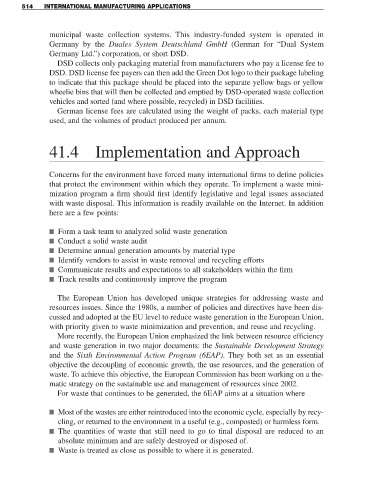Page 536 - Solid Waste Analysis and Minimization a Systems Approach
P. 536
514 INTERNATIONAL MANUFACTURING APPLICATIONS
municipal waste collection systems. This industry-funded system is operated in
Germany by the Duales System Deutschland GmbH (German for “Dual System
Germany Ltd.”) corporation, or short DSD.
DSD collects only packaging material from manufacturers who pay a license fee to
DSD. DSD license fee payers can then add the Green Dot logo to their package labeling
to indicate that this package should be placed into the separate yellow bags or yellow
wheelie bins that will then be collected and emptied by DSD-operated waste collection
vehicles and sorted (and where possible, recycled) in DSD facilities.
German license fees are calculated using the weight of packs, each material type
used, and the volumes of product produced per annum.
41.4 Implementation and Approach
Concerns for the environment have forced many international firms to define policies
that protect the environment within which they operate. To implement a waste mini-
mization program a firm should first identify legislative and legal issues associated
with waste disposal. This information is readily available on the Internet. In addition
here are a few points:
■ Form a task team to analyzed solid waste generation
■ Conduct a solid waste audit
■ Determine annual generation amounts by material type
■ Identify vendors to assist in waste removal and recycling efforts
■ Communicate results and expectations to all stakeholders within the firm
■ Track results and continuously improve the program
The European Union has developed unique strategies for addressing waste and
resources issues. Since the 1980s, a number of policies and directives have been dis-
cussed and adopted at the EU level to reduce waste generation in the European Union,
with priority given to waste minimization and prevention, and reuse and recycling.
More recently, the European Union emphasized the link between resource efficiency
and waste generation in two major documents: the Sustainable Development Strategy
and the Sixth Environmental Action Program (6EAP). They both set as an essential
objective the decoupling of economic growth, the use resources, and the generation of
waste. To achieve this objective, the European Commission has been working on a the-
matic strategy on the sustainable use and management of resources since 2002.
For waste that continues to be generated, the 6EAP aims at a situation where
■ Most of the wastes are either reintroduced into the economic cycle, especially by recy-
cling, or returned to the environment in a useful (e.g., composted) or harmless form.
■ The quantities of waste that still need to go to final disposal are reduced to an
absolute minimum and are safely destroyed or disposed of.
■ Waste is treated as close as possible to where it is generated.

